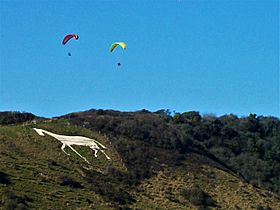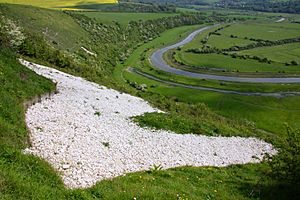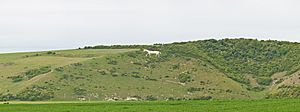Litlington White Horse facts for kids
The Litlington White Horse is a chalk hill figure depicting a horse, situated on Hindover Hill in the South Downs, looking over the River Cuckmere to the west of the village of Litlington and north of East Blatchington in East Sussex, England.
The current horse was cut in 1924 by John T, Ade, Mr. Bovis and Eric Hobbis in a single night and stands at 93 feet long and 65 feet high. A previous horse was cut in either 1838 or 1860 on the same site. Since 1991, the horse has been owned by the National Trust, who regularly clean and maintain the horse along with local volunteers.
The Litlington White Horse is one of two hill figures in East Sussex; the other is the Long Man of Wilmington which is situated 3 miles north-east from Litlington.
Original Litlington White Horse
The origin and date of the original White Horse is debated. One view is that it was created by James Pagden of Frog Firle Farm, along with his two brothers and cousin William Ade, in 1838 to commemorate the coronation of Queen Victoria. Another view is that the horse was cut in 1860 by two local boys, noticing a patch of bare chalk resembling a horse's head, they proceeded to cut away the rest of the horse to complement it.
Failure to maintain the horse meant it was completely covered by the early 1910s, with the last recorded sighting being the late 1900s before it was recut. Based on local records the original horse was likely located 100 yards to the north-west of the present horse, although its exact location is unknown.
Current White Horse
The current horse was carved by John T. Ade (the son of William Ade), Mr. Bovis, and Eric Hobbis in one night in 1924. A couple of these men are thought to have been descendants of the original horse's creators. During a full moon, the men cut the horse without the knowledge of the local residents, who awoke startled by the horse's appearance on the side of the hill; this may have been the motivation behind the speedy cutting.
The horse has since been maintained by local residents, although it was covered in the late 1930s so as to prevent it from being used as a location marker for the Luftwaffe in World War II. The uncovering of the horse after 1945 resulted in several changes to the horse's original shape, including only one leg being recut, which was not put back until June 1949 when several further changes were made to return the horse to its original appearance.
In the late 1980s, the East Sussex County Council scoured the horse and installed wooden boards around the horse to keep the chalk in place, alongside the installation of a perimeter fence to prevent damage from livestock. It was at this time that the horse was changed from a standing position to a prancing position, in order to prevent a slippage of chalk rubble used to fill the figure. The horse was last scoured in 2016. In May 2017 a unicorns horn was added to the horse, although it was quickly removed.
Situated on the peak of Hindover Hill is a free car park located along Alfriston Road, being only a short footpath walk down to the White Horse. A better view of the horse is, however, obtained from across the valley by walking south along the banks of the River Cuckmere from Litlington village.




